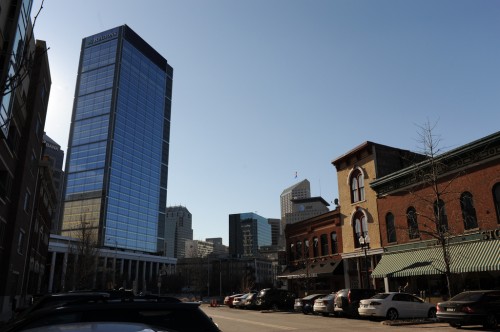
As part of my ongoing involvement as a member of the Green Line Citizen’s Advisory Committee, we were recently briefed on the latest details regarding the progress of the Environmental Impact Study (EIS) for the Green Line. I intend to cover the juicy bits of the recent news in the post regarding the specifics of the potential downtown route configurations.
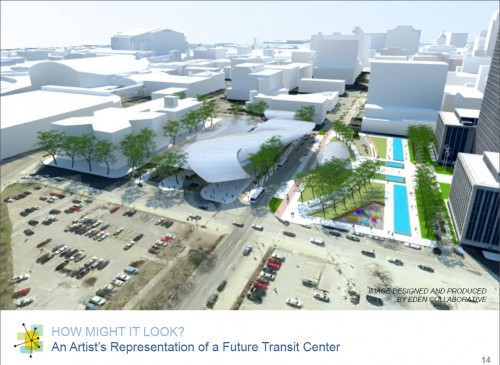
When the Green Line was originally announced, the  scope identified Union Station as the downtown terminal to interface with local bus service. This made sense as IndyGo has long assumed that a future downtown transit center would be located on the site of the US Post Office, south of South Street and across the street from Union Station. As study has moved forward however, IndyGo announced that they had selected a different location for the downtown transit center. Urban Indy has reported on this before and design is currently moving forward with the transit center at the intersection of Washington and Delaware Street, across from the City County Building.
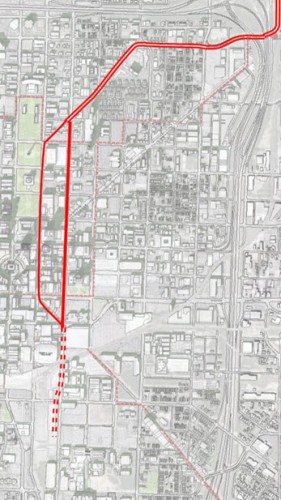
This announcement solidified the future of downtown bus transfers for the local IndyGo bus system. It also creates some new options for the Green Line. In addition to the previously announced routing of the Green Line along existing CSX freight right of way, planners now have a viable alternative for studying street-running light rail along the streets of downtown to interface with the new transit center instead of utilizing Union Station. I have reported in years past the amount of work that would be required simply to rehab Union Station; the street running alternative creates some cost saving options.
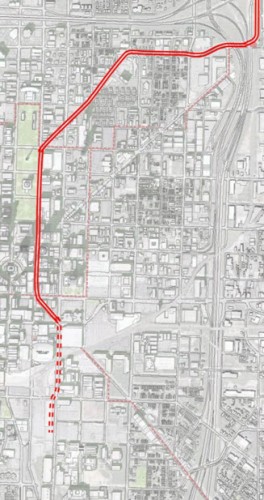
The realization of a downtown routing comes with many benefits as well as some potential trade-offs. Running on the streets means a more complicated routing, more stations, closer location to job centers, potential of heading off negotiations with CSX and a host of other benefits. As you can see, planners have refined the options to four potential configurations which would use either Fort Wayne Ave or Massachusetts Ave.
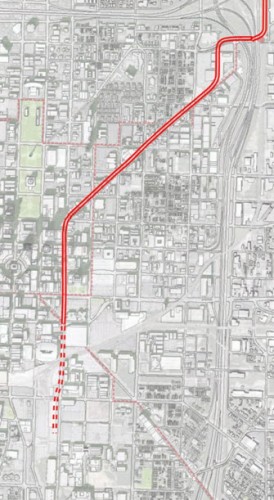
As you can see from the diagrams, both Fort Wayne Ave options would provide a direct corridor into the heart of the Pennsylvania/Delaware couplet corridors and a straight shot into downtown. Since the potential technology options include DMU trains with wider turning options, the routs reflect this with a Y-configuration. Trains would simply reverse once they began their trek back northward. Additionally, the possibility of extending the line southward to serve the Lily/Rolls Royce job centers would involve simply extending the track southward on Delaware Street.
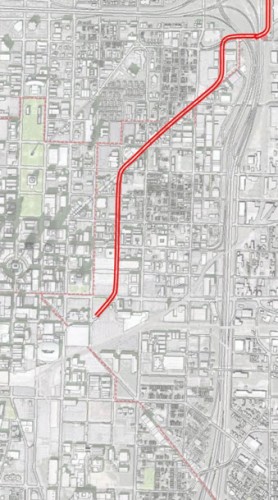
The Massachusetts Ave options offer a different strategy that would route the line further away from the core along New Jersey Street in one scenario and along Delaware with the other. The Delaware option could still take advantage of being able to serve Lilly & Rolls Royce as well. However, either Mass Ave option would require a restructuring of the current perpendicular parking orientation to a parallel parking design which would accommodate clearance for trains on the current automobile travel lanes.
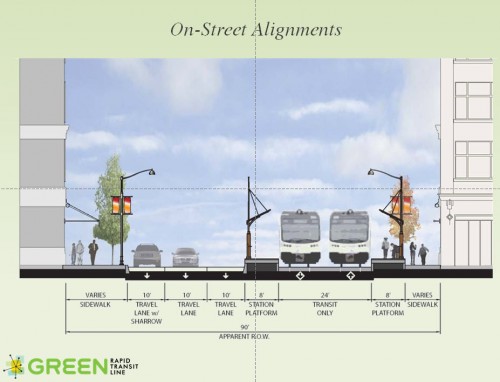
In both scenarios, if the option to use Pennsylvania or Delaware in a double track situation were to win out, existing parking would be wiped out. As you can see from the provided cross section, current travel lanes would be retained to accommodate the new rails while parallel parking would be eliminated.
To be sure, all of the downtown street-running configurations require a trade off with parking, automobile flow and potential interface with the downtown transit center location. However, all 4 seem to offer benefits that are head and shoulder above running trains along the CSX tracks.
What do you think?
For some reason, I really like the Fort Wayne Avenue option. Mass Ave is doing fine without this attention, but adding a stop at, say, Fort Wayne and Delaware could help revitalize that area. But, the ROW is quite narrow along FW, so that could be an issue.
I also am fine with having the vehicles on Mass Ave park perpendicular, as long as they also widen the sidewalks. That is something that certain Mass Ave boosters have been talking about doing for a long time, with or without the train.
I’m not familiar with all of the different stops, but I will say that I don’t know if it’s such a good idea to eliminate on-street parking. It activates the streets providing quick access to storefronts for motorists, but also creates a safer buffer between pedestrians and cars flying by. I understand something has to be sacrificed.
I do like the 10′ lanes. Makes the aisles feel much more compact almost forcing motorists to drive slower. A traffic impact study would be interesting to see if 3 lanes will even be necessary. Does the outside lane become solely for bicyclist if parking is to be removed?
If the lanes are 10′ in an urban area, I would actually prefer the idea of sidewalk widening at the expense of the bike lane. With narrow lanes and slow traffic, it’s much much more comforting as a cyclist, even more so IMO than a bike lane in 40mph traffic.
Agreed. As much as I advocate for cycling, wider sidewalks would be the greater good.
Love the idea of widening the Mass Ave sidewalks.
I would absolutely vote for Ft. Wayne over Mass Ave for two reasons:
1. Logistics: Ft. Wayne is underutilized for its ROW: it has four lanes northeast of Alabama and three southwest of there. It could easily accommodate transit without much disruption to existing patterns. Mass Ave presents some pretty substantial logistical challenges.
2. Job centers: Ft. Wayne goes right by the IPS admin building and the Federal Building and is just close enough (about 5 blocks) that you could probably capture some commuters going to Gateway Plaza and the Landmark Center as well.
The narrow RW portion of Ft Wayne in my comment was actually referring to the block between Delaware and Penn. I rode in a Megabus that turned down this block on accident. Talk about a bull in a china shop.
Good point — and that block is extra tight with the Cultural Trail bumpout that takes the Ft. Wayne-Penn intersection down to 2 lanes.
I know Andy would like to see Penn, but I’d be in favor of skipping that block and running down Delaware. The route is simpler that way and you get virtually the same proximity to the job centers that I mentioned.
I like Ft Wayne better than Mass Ave as well. It also gets pretty dang close to the Central Library compared to Mass Ave (about 3-4 blocks closer).
As for the rest, I say get the line as close to the Circle as possible. That means go down Pennsylvania. Not sure if both directions should go on Penn or just one and the other on Delaware, but definitely Penn in any case.
Not sure what I think is the better option. I see the station stop positioning as a very important decision and a game changer for both routes. A stop needs to be placed strategically close to the mass ave district. Maybe at the entrance headed east.
How would the ROW alignment look with BRT?
IMO, heavy commuter trains on streets downtown is just a bad, bad idea. It turns the trains into local buses if they have to move with traffic, which will add 5-10 minutes to the leg from 10th St. to the Transit Center.
Might as well just terminate the train at 10th and transfer people to a linked (i.e. waiting) downtown bus circulator running roughly the outer edges of the Mile Square (East, South, West, North Streets).
Chris, the trains being studied are essentially, light rail vehicles. They are a little longer than the traditional electric vehicles we see in most cities. There is talk that the technology could change between now and implementation. We are still years off from this.
However, the trains that are being studied are used in NJ, Austin and many European cities and successfully (and safely) navigate street environments without issue. I would not be too worried about that.
As for BRT, the route and treatments are being designed as if this would be dedicated guide-way for either mode.
I agree with Chris Barnett’s comment (I’m a different Chris). Why incur the extra expense and extra design and operational complexity along with the additional travel time of routing commuter trains (whether they are similar to light rail cars or not) along a a fairly short stretch of downtown streets when you can just terminate the commuter line at 10th Street and have a circulator bus to pick up commuters at the station? It seems like a much cheaper and more flexible solution.
Also, I have traveled on light rail cars in various cities throughout the world, including several very transit-friendly places like San Francisco. Quite honestly, light rail cars are rather slow, fairly noisy, and except for when they run on a dedicated right-of-way, such as a raised median or tunnel, they are not much better than buses (their advantage in normal street traffic is they can carry more people if you string enough cars together and they typically make fewer stops, but these advantages disappear when you compare them to a well-designed bus rapid transit system). Also, for short distances, like from 10th Street to downtown, as mentioned, a small fleet of circulator buses offers more flexibility to change routes, frequency, and to maneuver around accidents/obstacles–and purchasing circulator buses is cheaper).
I prefer Mass Ave option 1. I do because not only does it go through a major hotspot in Indianapolis, but it does get closer to major job center by going on Penn. Delaware is a little sketchy for suburbanites to walk to/from. Also, the system will get close to the library, as I saw from a recent comment, although from the red line, not green. The only problem I see is having light rail on Mass. Ave with cars. Possibly they could make it a pedestrian mall type thing with only light rail, maybe some sculptures and cafes. Heres an image of one http://upload.wikimedia.org/wikipedia/commons/thumb/d/d3/2006-04-23_-_16th_Street_Mall_from_D%26F_Tower.jpg/450px-2006-04-23_-_16th_Street_Mall_from_D%26F_Tower.jpg
I like the Fort Wayne option and think it should just continue down Delaware instead of Penn. Unlike Penn which is lined with: parks, monuments, older buildings, and skyscrapers; Delaware is underdeveloped and has a suburban/intimidating feel. Having these lines go down Delaware could drive some serious development that the area needs. The same goes for Fort Wayne vs. Mass Ave. Imagine if Delaware and Fort Wayne were both lined with large apartment/condo buildings and retail. The entire NE quad of Downtown would be completely developed and become “the neighborhood to live in” for Indianapolis. You could see a scenario where Fort Wayne, Delaware, and Mass Ave were all commercial destinations.
My bottom line is that Mass Ave has enough going for it already and Penn has a lot of potential on its’ own. If the transit lines are put in areas that aren’t heavily developed already (yet still very close to Mass Ave), the potential for future growth could be huge.
After reading this and other comments, I take my initial assessment back. I thing the Red Line will be a good approach for the Central Library and I agree that Delaware is mostly a race track and underutilized, so I would like to change my vote to Fort Wayne to Delaware.
Also, have any studies ever been done on turning Mass Ave into a pedestrian zone from College to, say, Alabama? Keep all the east/west and north/south streets through, but remove vehicle traffic on Mass Ave itself. I’ve never really thought much about this, but I’m intrigued.
The proposed section results in 10 ft. wide sidewalks for most streets within the mile square. With a traffic lane directly adjacent, this could prove to be very uncomfortable for pedestrians, particularly when one considers the increased ped traffic and desired sidewalk amenities as a result of TOD along the route. Suggested refinements include adding 2 ft. to sidewalk and convert travel lane to parking. On the platform side, if it were at the same grade as the sidewalk, then this side of the street could have a much more generous sidewalk area that doubles as the platform; street trees and other street furnishings could provide the separation where needed.
I’m not for sure how I feel about either option. For starters, I am completely in favor of commuter rail lines being established on 6 CSX lines that extend from downtown. Also, there are 4 other railroads that traverse the city, including one, the nickel plate corridor, which I thought was supposed to be the original green line. What happened to that idea? I would like to know how much is the plan saving by not renting the existing freight ROW in the city. One night when I was looking at all the indyconnect info, a google map, and an Indiana railway map, I wondered why couldn’t we make develop a commuter rail system with stops and fares like this:
[IMG]http://i1323.photobucket.com/albums/u592/shayloure/PossibleIndyCommuterRoutes_zps8b4e8337.png[/IMG]
[IMG]http://i1323.photobucket.com/albums/u592/shayloure/PossibleIndyFareZones_zpse4c76314.png[/IMG]
Hey Shayla,
I was at the Indy Connect meeting tonight at U of Indy. They were mentioning that there were two reasons for not using the existing ROW. Going north it would be possible, but not going south to Greenwood because 1) CSX has expansion plans for the freight down that direction and 2) The ROW is not wide enough to accommodate a second set of tracks.
Also, they want to bring all the transit through the new transit center at Alabama/Delaware and Washington. If they did heavy rail, it would have to run through Union Station and would disconnect it from the rest of the system.
Here’s the direct link to the aforementioned images:
http://i1323.photobucket.com/albums/u592/shayloure/PossibleIndyCommuterRoutes_zps8b4e8337.png
http://i1323.photobucket.com/albums/u592/shayloure/PossibleIndyFareZones_zpse4c76314.png
Mass Ave, so I am now siding with option one. Indianapolis can come up with a creative way to solve the parking problem. This could become an iconic neighborhood for at least the mid-west, which is exciting!
Back on topic…I prefer the Fort Wayne Ave. alignment. There are too many other demands on Mass Ave ROW.
However, with future Red and Orange lines coming into downtown from the “straight north”, I wonder if an alignment SB on East and NB on College wouldn’t be the best since this line is not a through route. Those are the two closest arterials to the 10th/Monon/NKP/I-65 junction.
Or…way outside the box, use the already-in-place I-169 “ramps” onto and off of I-65/70 collector/distributor. From/to 16th & Monon, the SB line would exit at Ohio to access the Transit Center. The NB return would use the Pine St. onramp to 65, from which the I-169 “exit” is graded and in place to return to the NKP. Of course, this only works for BRT, and it would require swapping the Monon and NKP lines somewhere around 16th or further north to avoid the need for bridging.
Hot damn, I’ve wondered about a good use for the I-169 ramps for years. That would be VERY creative, but not without challenges. Using the Ohio St. on/off ramps would still run you straight by the towers in the CBD on the way to the transit center, so you maintain that access to major job sites.
On the downside, you’d have to get really creative in providing a dedicated lane for the buses while they’re on the expressway, otherwise rush hour traffic would kill everything. And certainly getting INDOT involved with the transit system will be a massive headache.
Very interesting.
I have driven through Columbus, OH on I-70 several times recently. They have signs posted: No Driving On Shoulder Except Approved Transit Buses.
🙂
Before designing or routing a line or lines*, might not it be worthwhile to learn lessons from elsewhere? They might be relevant, no? I didn’t see any knowledge, insight, wisdom -or cautions- offered or posted here.
* which is mere temptation, a game anyone can play
The professionals get paid for that. Our part in this drama is to tell them what we want here in Indy.
This post answered a question I had elsewhere about Union Station — apparently rehabbing it and retrofitting it as a transit center (as well as the CSX line negotiation issues) is too cost prohibitive. Very well.
I followed HB 1011 through the state legislature very closely this year, and there was a lot of discomfort with the Green Line component of the plan because it’s a rail line and could get expensive over time. If the rest of the plan can achieve some cost savings with bus rapid transit while still delivering prompt service, then why not use BRT for the Green Line as well to save money? Just because we have this rail corridor available doesn’t mean we have to use it for rail.
I’m agnostic when it comes to the mode of transportation as long as it gets people where they want to go cost effectively and actually stands a chance of getting through the legislature.